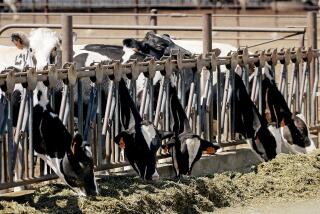U.S. to Slaughter Dairy Stock to Reduce Surplus
- Share via
The Agriculture Department said Friday that it will buy and slaughter enough of the nation’s dairy herd to slash milk production by 8.7% under a novel program aimed at wiping out the present surplus without significantly boosting retail prices.
More than 182,000 cows, heifers and calves in California--the second-largest dairy state after Wisconsin--will be slaughtered under the program, bringing their owners a total of $277.1 million. That is more than $100 million above any other state’s total.
Nationwide, about 10% of the 11.1-million-head dairy herd will be marked for slaughter or export over three six-month intervals. The intervals in the liquidation represent an effort to avoid glutting the already depressed red-meat market. Animal rights groups took strong issue with the requirement that herds first be branded with a 3-inch X on each animal’s jaw--a placement they contend is unnecessarily painful and cruel. But the department maintained that no other adequate means of marking the herds is readily available. The branding is needed to assure that designated herds remain out of production for five years, the department said.
The government asked for bids from dairymen willing to sell their entire herds and stay out of production for five years. It received bids from 39,534 dairy farmers representing 23.5% of national milk production. The maximum accepted bid was $22.50 per 100 pounds of production--about 12 gallons of milk. Bids ranged from $3.40 to more than $1,000.
Dairy operators are being assessed for 38% of the program’s estimated $1.8-billion cost, with taxpayers providing the rest under the 1985 farm bill, which authorized the unusual program. The major beneficiaries will be dairymen under heavy debt and the government itself, which spends millions annually on buying surplus dairy products.
The effect on retail milk prices will be “minimal,” predicted Roger Korsmeier, chief executive of the California Milk Producers, an Artesia-based cooperative that markets about 12% of the state’s milk production.
Bid results were announced in Washington by Richard E. Lyng at his first meeting with the press since succeeding John R. Block last month as secretary of agriculture. Lyng said the effect on retail prices will depend on the extent to which supply falls relative to demand. Reducing the nation’s herd 10% could have “a very favorable impact” on farmers, he added.
Branding will begin as early as Tuesday and conclude by mid-April. Humane and animal-rights advocates and some farmers protested that branding the neck or notching ears would be as effective and less traumatic. Some said they planned to stage a protest Monday in front of USDA headquarters.
More to Read
Sign up for Essential California
The most important California stories and recommendations in your inbox every morning.
You may occasionally receive promotional content from the Los Angeles Times.













